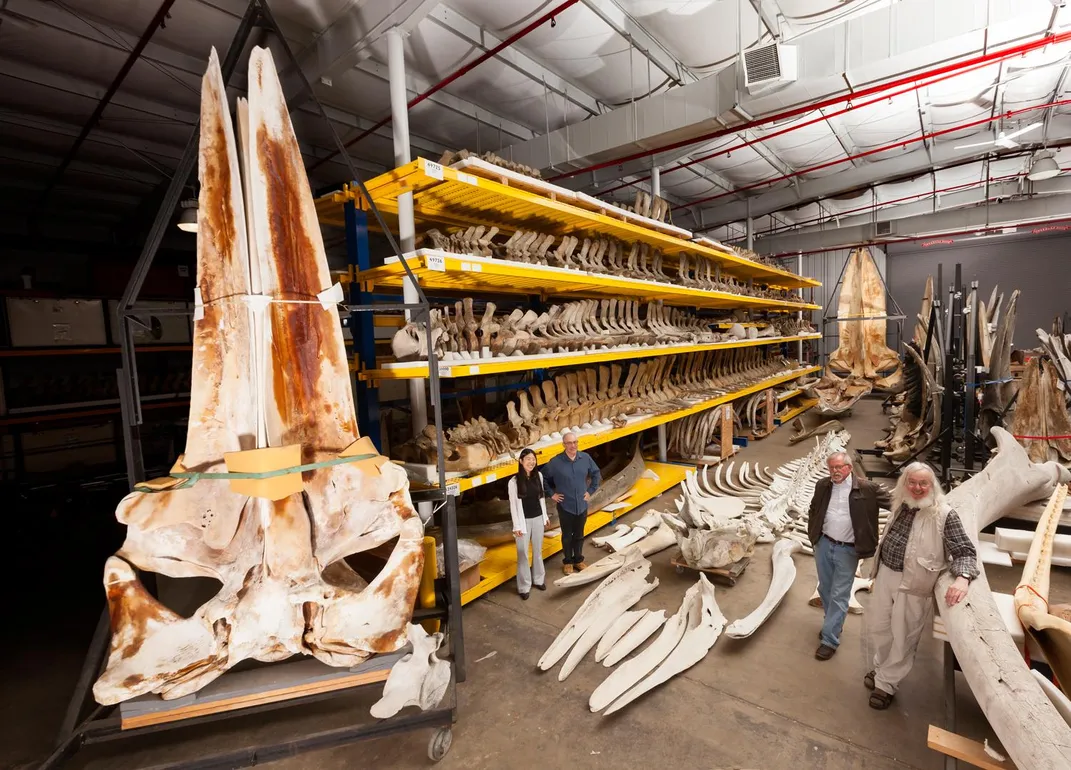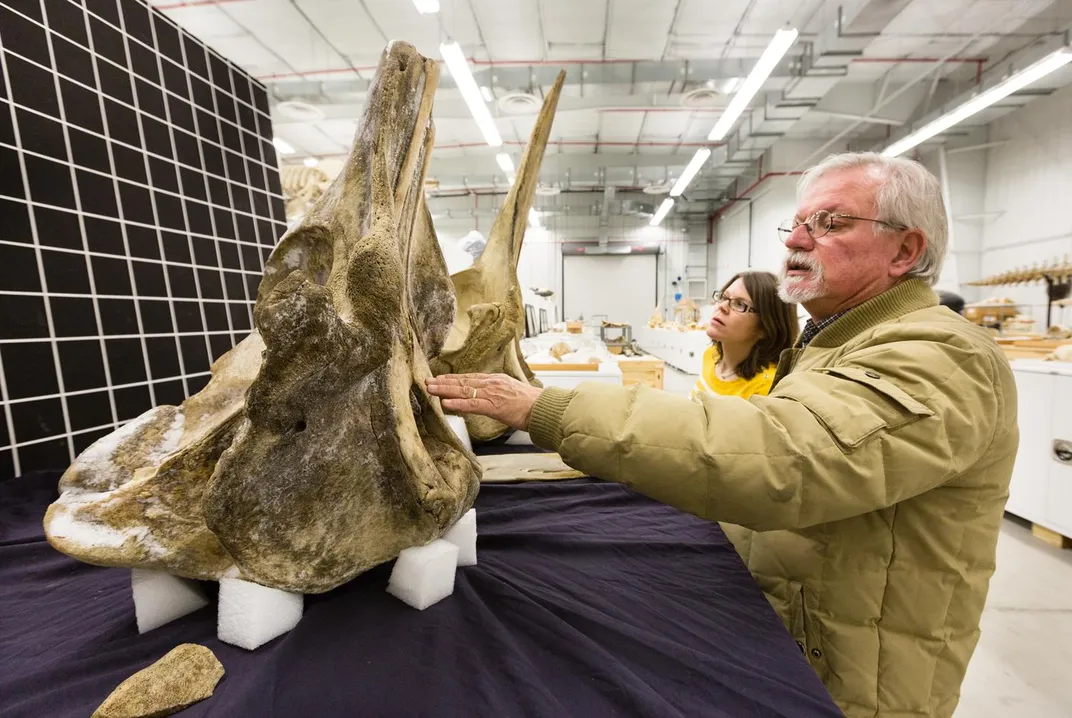For Scientists, Chunks of Whale Earwax Can Be Biological Treasure Troves
Biologists are waxing poetic about these unusual oceanic core samples found in the ears of cetaceans
/https://tf-cmsv2-smithsonianmag-media.s3.amazonaws.com/filer/99/84/99842822-c0ba-489a-9672-45bec36eb356/whaleearwax.jpg)
Whale earwax? Really? It’s weird on so many levels—that whales even have earwax, that someone thought to go looking for something like that, and that the Smithsonian’s National Museum of Natural History has stored not one, not ten, but about 1,000 samples of whale earwax plugs for well over 50 years.
And those samples, which not very long ago were gathering dust and some questions about their value, are now turning the scientific community on its (wait for it) . . . ear.
That's because they are far more than the odd, quotidian and rather gross objects that they seem. We are learning now that samples of whale earwax are quite possibly unique in their ability to describe the life history of the longest-lived marine mammals, as well as give us a glimpse into a place and a time we cannot reach any other way. They are, in effect, physiological and ecological time capsules, and to research scientists who are trying to better understand the world’s oceans they are solid gold.
“It’s a good example of specimens which were collected for one purpose many, many years ago—the first ones were collected at the turn of the 20th century or so—and now as we find another way to interrogate these specimens, we’re able to discover that they have a whole other story to tell,” says Smithsonian researcher Charley Potter, who was the museum’s collection manager in the vertebrate zoology division until he retired in 2015.
“We’re going to start asking questions that nobody has even thought of asking of these animals, because nobody can go back in time. But these enable us to do that,” says Stephen J. Trumble, an associate professor of biology and animal physiologist at Baylor University. “At times it almost seems overwhelming because we’re getting so much information.”
Like most innovations in science, the study of whale earwax—a.k.a. earplugs—as oceanic core samples came about by asking a question no one had thought to ask, and by examining the obvious from a completely different perspective.
Back in the day, when we slaughtered whales with reckless abandon, whalers discovered the earplugs when they dissected the heads of their unfortunate quarries. A whale earplug from the collections of the Natural History Museum is one of hundreds of rarely displayed specimens on view in the exhibition, “Objects of Wonder,” opening March 10, 2017. The show examines the critical role that museum collections play in the scientific quest for knowledge.

“The external ear canal in cetaceans is sealed at the surface,” says marine biologist Randall W. Davis, at Texas A&M at Galveston and a leading marine mammal physiologist. “There’s a remnant of the external auditory canal, but it isn’t open to the environment. Oil is still secreted in the ear, but it accumulates in this marvelous organic matrix that has been laid down in very distinct layers.”
Much like a tree’s rings, the layers transition regularly from dark to light, indicating periods of growth. Since the early 1900s, Trumble says, scientists figured out that these layers could be used to approximate an animal’s age. But that’s pretty much all they were used for, other than being displayed as curiosities.
One day about five years ago, Trumble, who specializes in marine mammal physiology, was talking about these layers with his colleague Sascha Usenko, director of Baylor’s Environmental Science Graduate Program and an atmospheric and environmental chemist.
“And he said, ‘It’s a lot like the sediment core stuff where you count layers in the sediment,’ and we both looked at each other and said, okay… ’’ In Usenko’s experience, sediment cores were treasure troves of information about past climate and environments.

“They are capable of recording and archiving chemical information, and we can get trends from that information,” he says, “reef cores, ice cores, all kinds. When we match up the chemical profile to a time sequence, we can reconstruct what some aspect of the environment was like in the past. The amount of information that has come from those types of matrices is overwhelming.”
So what questions could the organic matrix that is a whale earplug provide an answer to?
They asked Potter if he had any whale earwax in the Natural History Museum’s collections. Did he ever. In the late 1960s, toward the end of the United States’ participation in industrial whaling, the Bureau of Fisheries (now the National Marine Fisheries Service) harvested a variety of tissues and samples from dead whales for study. The earplugs ended up at the Smithsonian Institution—pallets and pallets of them.
Excited about Trumble’s and Usenko’s theory, Potter offered some earplugs and ideas about what they could possibly reveal. After about 18 months just figuring out how to successfully process the samples, their early work showed patterns in environmental contaminants similar to what they had seen laid down in tissue like blubber, which corresponded to periods of feeding following times of migration and fasting.
Following up with more questions and an earplug from a blue whale that had suffered a ship strike off the California coast and washed up in 2007 (provided by the Santa Barbara Museum of Natural History), Usenko, Trumble, Potter and two other co-authors published a paper in 2013 in the Proceedings of the National Academy of Sciences.
It described how the blue whale’s earplug not only captured a history of the contaminants the whale had encountered throughout its life, but also its own physiological log of hormonal changes and chemicals related to stress that the scientists could link to major life events like puberty, pregnancy and birth. These basic data could help scientists ground-truth assumptions they had been using to determine age, gestation periods and birthrates, for instance—all information that helps policymakers make better-informed decisions on species management.
Perhaps even more important, the earplug provided all this data on a measurable timeline to within six months’ accuracy. Since each band in the plug was laid down in approximately six-month intervals, researchers could determine with great precision when a particular exposure or event occurred. And they knew that earplugs would also allow them to define baseline data from which they could compare and measure not only one whale’s exposure to things like mercury and pesticides through its life in various waters, but also other whales in other oceans and other decades for comparative study—a chemical and biological history not only of the whales, but the oceans they swam in.
For instance, it is now possible to examine an earplug taken in 1910 from a gray whale who was in the Pacific off San Francisco—which, depending on its age, could have been living in the early to mid-1800s—and compare its data to a gray whale in the same ocean in 1970 or the present (if one washes up dead, which is the primary way that scientists obtain contemporary samples).
Were birthrates the same? What contaminants were present in one but not the other, and why? Where did such contaminants possibly come from? Were stress levels the same, and if not, why not? What caused stress events? The questions become almost endless.
“It’s even more unique than something like sediment, because it represents an individual and it gets to move around, and they have ridiculously long lifetimes, and a lot of times they live in parts of the planet we often don’t get access to,” Usenko says. “It’s such a powerful tool that people have basically told us, ‘I never thought I’d be able to ask these questions.’ ’’
“They have found a completely new window into the physiology and environmental exposure to certain chemicals . . . questions which are very, very hard to answer otherwise,” says Davis. “If you go harpoon a whale and analyze all its tissues you have a single snapshot in time that might represent a few weeks or months. But if you had a physiological recorder in that animal running its entire life then that becomes incredibly valuable, and that’s what these are.”
Now that they have begun to uncover the earplugs’ mysteries, Usenko, Trumble and other scientists are mining these specimens for data. So far they’ve processed about two-dozen plugs—some from the Natural History Museum’s collection, others from museums around the world, still others from contemporary native Inuit bowhead whale hunts—trying to span generations, geographies and species. (Note: Not all whales generate earplugs. Smaller species, for instance, have differently shaped ear canals that can’t accommodate them.)
Trumble is interested, for instance, in external forces that create stress. Why, for instance, do cortisol levels—a chemical measure of stress—go up and down in a recently killed bowhead whale from Barrow, Alaska, whereas in the 2007 blue whale, stress levels were consistently high?
“Is this a function of where the blue whale was, like a heavy shipping area? Or was it just that animal itself?” he asks. He’s also trying to see whether animals from, say, the 1980s, were more stressed than those swimming in the 1920s; so far, data is indicating that baseline stress levels were lower in animals generations ago. “We don’t know what to attribute that to; is it noise, chemicals, food, lack of food? We don’t know yet. . . with every plug we get, it seems like there are more questions we have to answer.”
“Objects of Wonder: From the Collections of the National museum of Natural History” is on view March 10, 2017 through 2019.
/https://tf-cmsv2-smithsonianmag-media.s3.amazonaws.com/accounts/headshot/WendyClarke1.JPG)


/https://tf-cmsv2-smithsonianmag-media.s3.amazonaws.com/accounts/headshot/WendyClarke1.JPG)